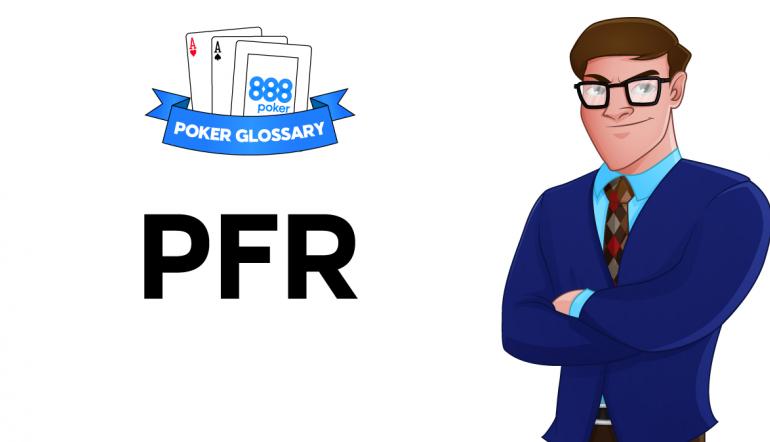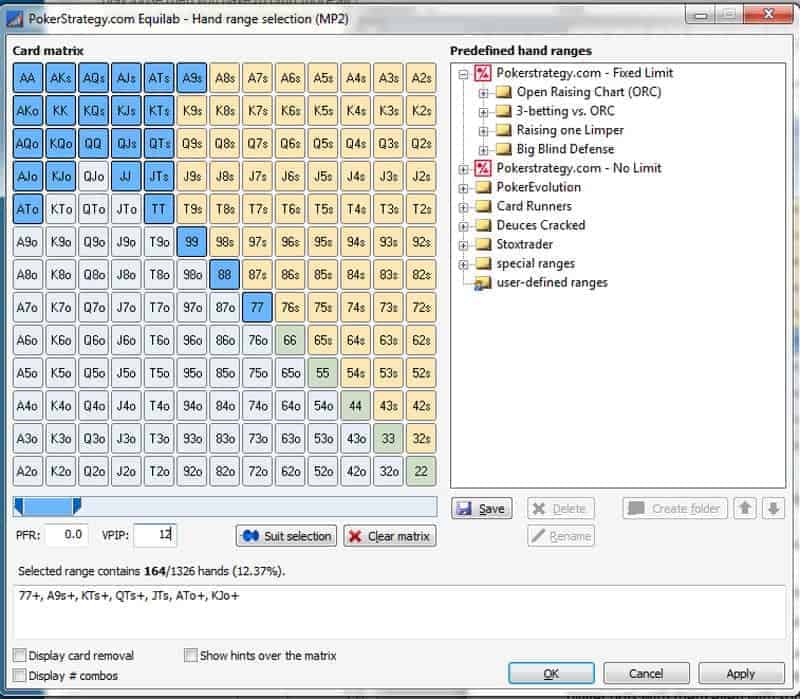Poker Pfr Meaning
The main tool being used by majority of online players is the HUD (Heads-Up Display) available through poker tracking software. This tool provides a whole range of statistics on your opponents which allows you to gain extra information when making decisions at the table. When HUD’s were first introduced into poker not many players were using them due to the unfamiliarity with the program. However, the top online players quickly adapted to them which gave them an even bigger edge at the tables.
Statistics and math are a valuable tool in poker now despite not all players believing so. The great aspect of using a HUD is that it can be designed to whatever suits you as a player. Some players prefer basic stats to use a guideline whereas others prefer using as many statistics as possible to determine how their opponents are playing.
PFR stands for “preflop raiser”. It indicates how many hands a player raises on the first betting round (preflop in Hold’em). It’s calculated as follows - Number of Raises Preflop / Number of Raise Opportunities Preflop. PFR Poker (Preflop Raise) Simply put, the PFR poker statistic tells you about how often a particular player enters the pot with a raise. This serves as a much more oriented number as it gives you a clearer image about the level of aggression your opponent is used to playing with.
- A high PFR lets us know that a player is raising and playing a lot of their preflop hands aggressively. A low PFR can mean various things, and this is why we usually look at VPIP and PFR together. A large gap between those VPIP and PFR implies that a player is more passive, whereas a small gap implies they are more aggressive in general.
- VPIP / PFR / 3B / F3. Meaning: 1) VPIP: Voluntarily Put Money in Pot, i.e. How often a player raises & calls. The higher the stat, the looser the player 2) PFR: Preflop Raise. How often the player raises preflop. The bigger the gap between VPIP and PFR, the more passive the player is. 3) 3B: 3-bet percentage preflop, how often the player re.
When using a HUD you need to make sure that you use the information given to you over a large sample as opposed to few hands: Making decisions based on players stats over a 20 hand sample might not give a true reflection of how they actually approach the game.
I would start to make decisions based on the HUD after an 80 hand sample or more as by then you’ll have a better indication of how someone is playing simply due to a more reliable sample of hands. Some of the following stats are typically used on a default HUD.
VPIP (Voluntary Put in Pot)
This statistic is used to show how many times a player voluntarily puts chips into pot e.g. limping, making a raise or calling a raise. However, it does not take into account the small and big blind position as they are both mandatory. VPIP is an important statistic and helps us identify if a player is tight, loose, solid or an extremely fishy player. The following categories show what number will relate to an opponent's playing style.
VPIP Numbers
0-10 - Tight player
11-20 - Tight players will have a VPIP of unto 13/14 but other statistics will determine how tight they are. Loose passive/aggressive players will also show a number in this range.
21-30 - Loose aggressive players will show a number around 21-25 but anything higher usually indicates a weaker fishy style of player. However, extremely aggressive/good players can show a VPIP in this range.
30+ - Weaker/fishy players
PFR (Pre-flop Raise)
This statistic is displayed in the HUD to show how many times an opponent has raised before the flop. This will indicate how aggressive/tight your opponents are which will help you identify a specific hand range which you can assign to certain players. The following number ranges will help you determine what style of player you are playing against.
PFR Numbers
0-10 - Tight player
11-20 -Tight players will tend to have a PFR capped at 12/13 but anything higher will be determined as just a regular aggressive player.
21-30 -Some aggressive/good players will be playing with a 21/22 stat but anything higher is a super aggressive player who are playing too many hands.
30+ -This range is usually assigned to fishy/weak players who are overplaying hands dealt to them.
3-bet

This statistic is used in the HUD to show us how many times our opponents re-raise another opponents raise pre-flop (the third bet). It's an extremely important statistic to use in the current era of poker and will help you understand how your opponents are playing and how you can exploit them depending on the % of hands they 3-bet. The following categories will determine how much your opponents are3-betting and what that necessarily means.
3-bet numbers
0-3 - This usually indicates a tighter player who will only 3-bet their value hands.
4-6 - This will indicate a fairly aggressive opponent who is still fairly tight but will be 3-betting some hands as a bluff.
7-9 - This statistic in the HUD will indicate a much more aggressive player who is 3-betting a vast amount of hands and will be trying to put pressure on opponents majority of the time.
10+ - With a 3-bet % of 10 or more, this will indicate an extremely aggressive player who is 3-betting way more than often showing that they are trying to run over the table or exploit the weaker opponents at the table.

Essentially, the more your opponents 3-bet the more you need to adjust to that player and figure out how to exploit them. This could be by only opening a strong range of hands with that player left to act or deciding to 4-bet bluff on a few occasions to play back at your opponents.
Fold to 3-bet
This statistic tells us how often a player will fold to a 3-bet pre-flop. Using this stat in our HUD is extremely important is it will give us enough information to determine how aggressive or tight we can play against particular players. If a player is opening a wide range of hands from a specific position and has a high fold to 3-bet then we can decide to 3-bet a wider range of hands. The following categories will determine how much your opponents are folding to 3-bets and how we react to that.
Fold to 3-bet Numbers
0-20 - This indicates that a player is not folding to 3-bets that often therefore we should only be 3-betting our value hands.
21-40 - This also indicates that a player will not fold to that many 3-bets but we can still pick our spots to 3-bet light especially if a players fold to 3-bet is close to 40.
41-60 - With a fold to 3-bet in this range, we can start to widen our 3-betting range against these players as enough of the time they will fold.
61-80 - Players that fall into this range will be relatively passive players therefore we can 3-bet them with marginal hands and play against these players in position a good amount of the time.
80+ - This indicates that majority of the time our opponents are folding to 3-bets therefore similar to the last category, we can be 3-betting more than usual against these players and exploiting them.
It's important to make sure that you adapt to different types of players but remember your own image at the table. Whilst it's fine to 3-bet a wide range of hands against players who have a high fold to 3-bet, you have to consider that our opponents will adapt to what we are doing at the table. Therefore, pick your spots and you don't always have to take a 3-bet spot, balance your play as much as you can.
ATS (Attempt to Steal)
This statistic tell us how often a player is raising from late position attempting to steal the blinds. Usually, a player will be attempting to steal from the HJ+ (Hijack) as there are less players left to act that will show resistance to the raise. Using this statistic in a HUD is extremely important in tournament poker as stealing blinds is a great way of accumulating chips. We will able to identify a more accurate range of hands that our opponents are opening with when attempting to steal based on the number shown in the HUD. Additionally, using the fold to 3-bet stat in conjunction with the attempt to steal stat, we will be able to identify how often they are stealing from late position but folding to 3-bets, which will give us a good indication of whether or not we can play back at our opponents . The following categories will show what certain statistics mean and how we can adapt to them.
ATS Numbers
Poker Pfr Meaning Name
0-20 - This indicates that our opponents are not attempting to steal that often therefore we can defend the blinds with a stronger range of hands and not play back at these opponents too much.
21-40 - This shows that our opponents are starting to steal a little wider therefore we can show some resistance by 3-betting or playing against them in position.
41-60 - With an attempt to steal stat in this range, this suggests that our opponents are raising a little wider in late position. Therefore, we can 3-bet a little wider in position against the right opponents and we can defend a little wider from the blinds if necessary.
61-80 - This indicates that our opponents are raising a wide amount from late position and we should be playing against them as much as we can in position to try and combat them. Typically, we will start to widen our 3-betting range and put more pressure on our opponents.
80+ - Similar to the last category, this suggests that our opponents are opening close to 100% of their range therefore we need to be playing back a good amount of the time or playing in position against them. These are the type of opponents we can attempt to trap and play our big hands in position to try and win the maximum.
Poker Pfr Meaning Dictionary
As much as these categories help identify the types of players we are up against, if we play back against them too much they will start to adjust their opening range and try and induce a mistake out of us. It's important to balance your play rather than constantly 3-betting a player that is stealing 80% of the time. Thinking about our own image is just as important as our opponents image.



